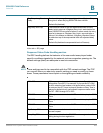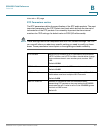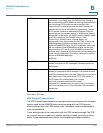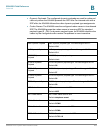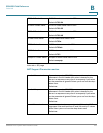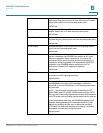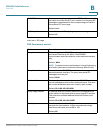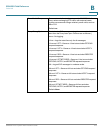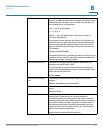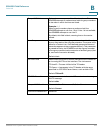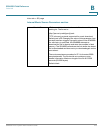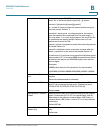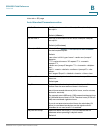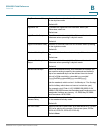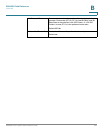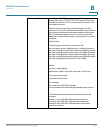
SPA9000 Field Reference
Voice tab
SPA9000 Voice System Administration Guide 214
B
Call Routing Rule Special dial plan that determines which line interfaces can be
used for an external outbound call request from client station
based solely on the target public number. The dial plan is in
the (
rule
|
rule
|…|
rule
) format where:
rule
= <:L
n
[,
n
[,
n
[,
n
]]]>
pattern
n
= 1, 2, 3, or 4,
pattern
= any digit pattern (see <Dial Plan> on how to
choose a digit pattern).
If the target number matches the pattern of a rule, the Line
indices in the rule’s prefix are the line interfaces that can be
used to make that call. Matches are performed from left to
right, so make sure the most specific rules are placed first.
For example:
Default: (<:L1,2,3,4>9xx.)
The default call routing rule specifies that any of the four line
interfaces can be used for any target number starting with 9
followed by at least 2 more numbers.
Call Park MOH Server The MOH Server to be used to handle a parked call. For
example: mohs@192.168.1.1:5082.
If this parameter is not specified, the internal parking lot is
used to host the parked call, in which case the parked caller
hears the internal music file.
Default: imusic
Call Park DLG Refresh
Intvl
The interval in seconds between refreshing a call park
session.
Default: 0 (disables session refreshes)
Default Group Line Same as <Group 1/2/3/4 Line>, but applies to the default
group.
Default: 1,2,3,4
Group 1/2/3/4
User ID Comma-separated list of User ID patterns. A client station
whose User ID matches any of the give patterns is
considered to belong to that group. If the User ID matches
more than one group, the smallest group number is assumed.
If the User ID does not match any group, the client station is
considered to belong to the default group (also known as
Group 0). Each User ID pattern allows * and ? wildcards as
well as %xx escaped characters.
Default: blank (includes all client stations)



